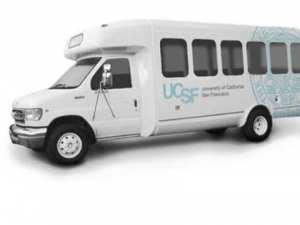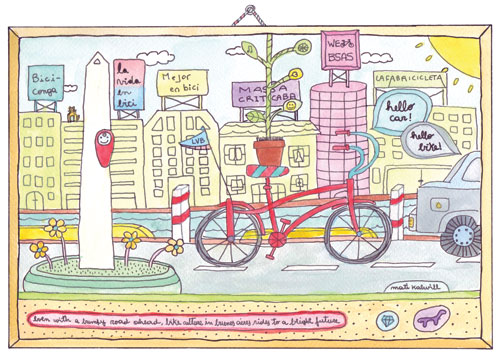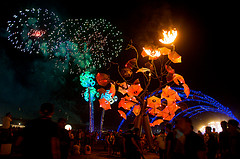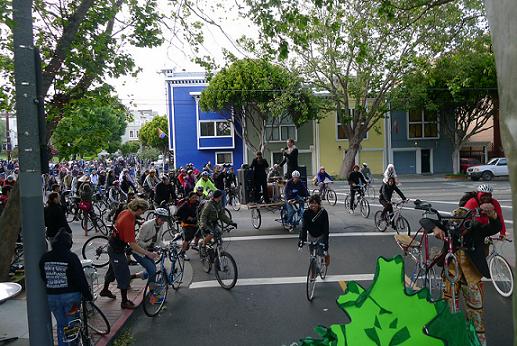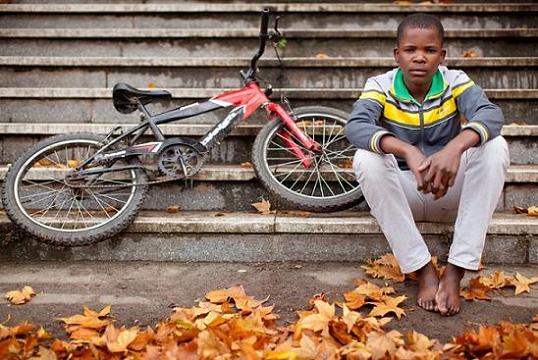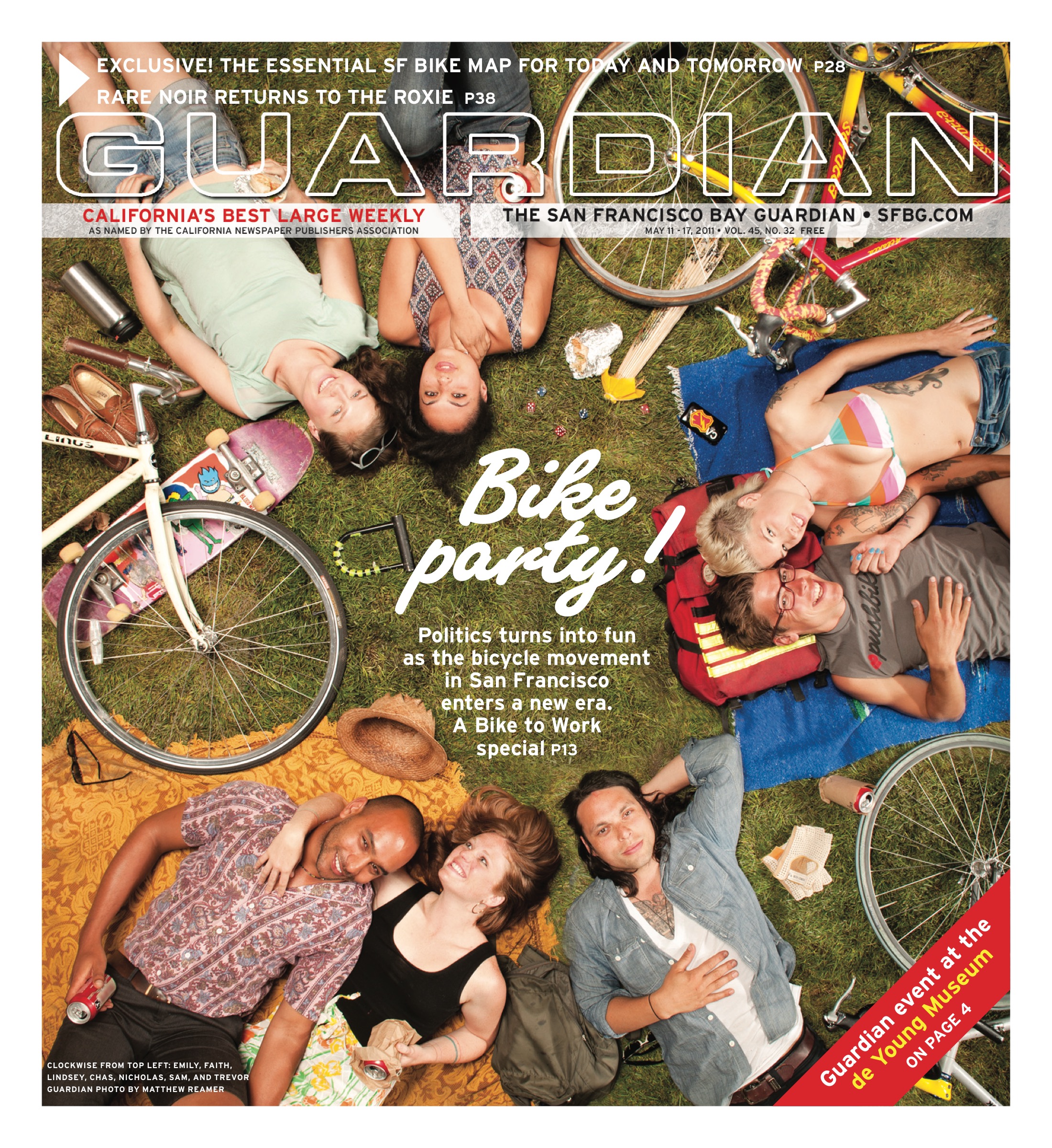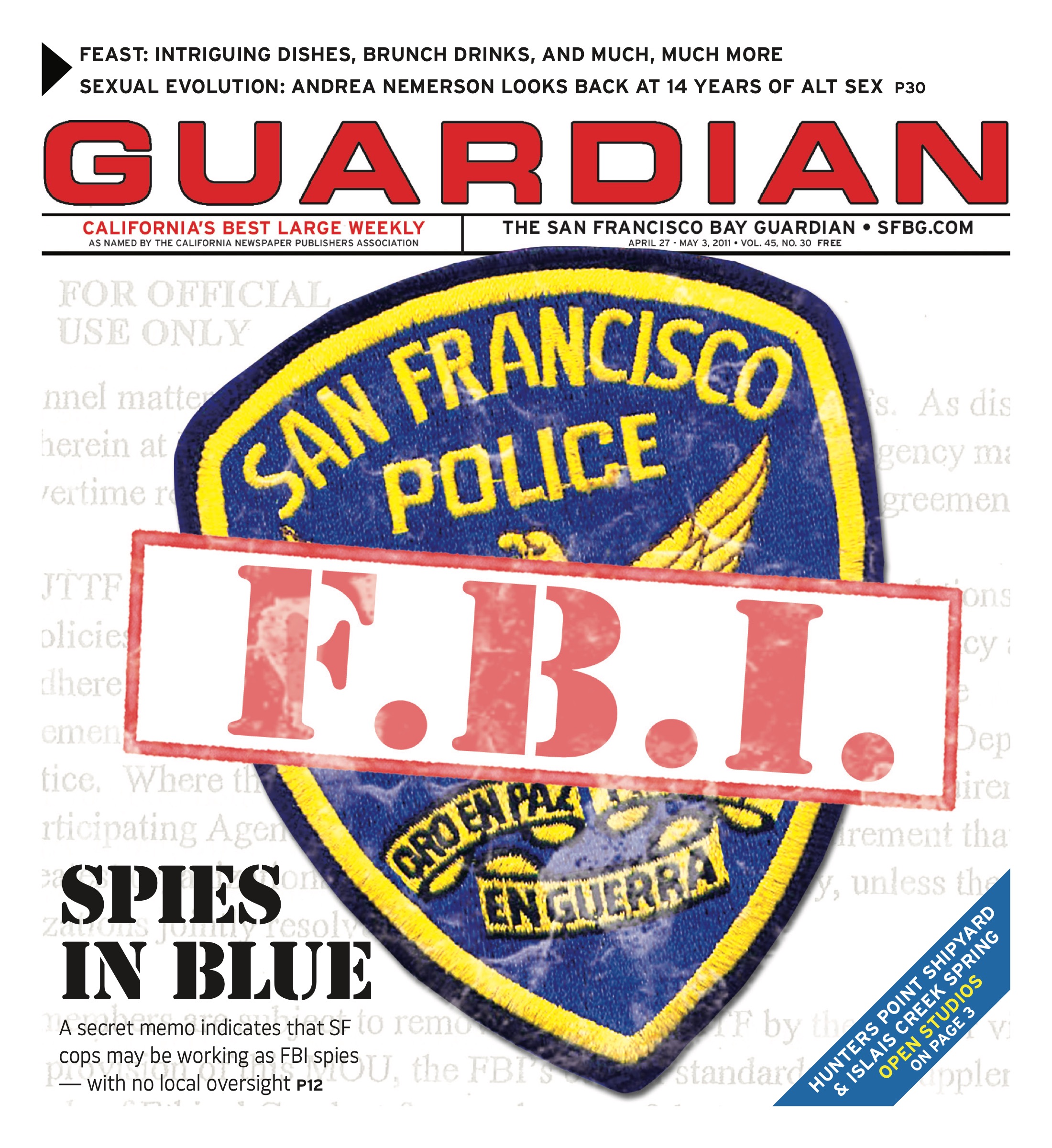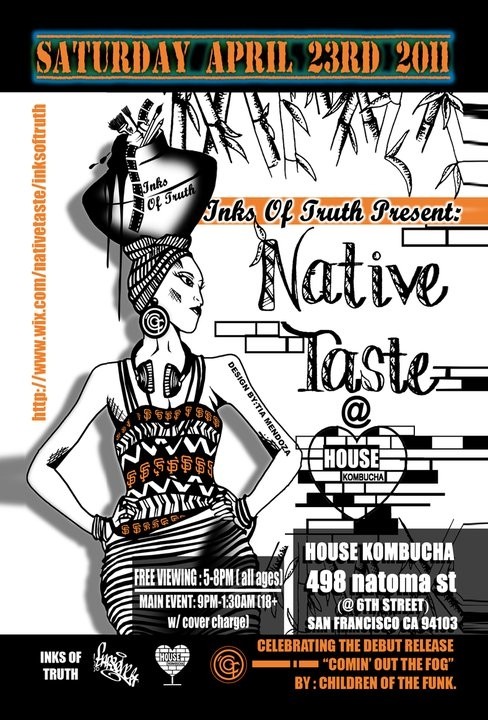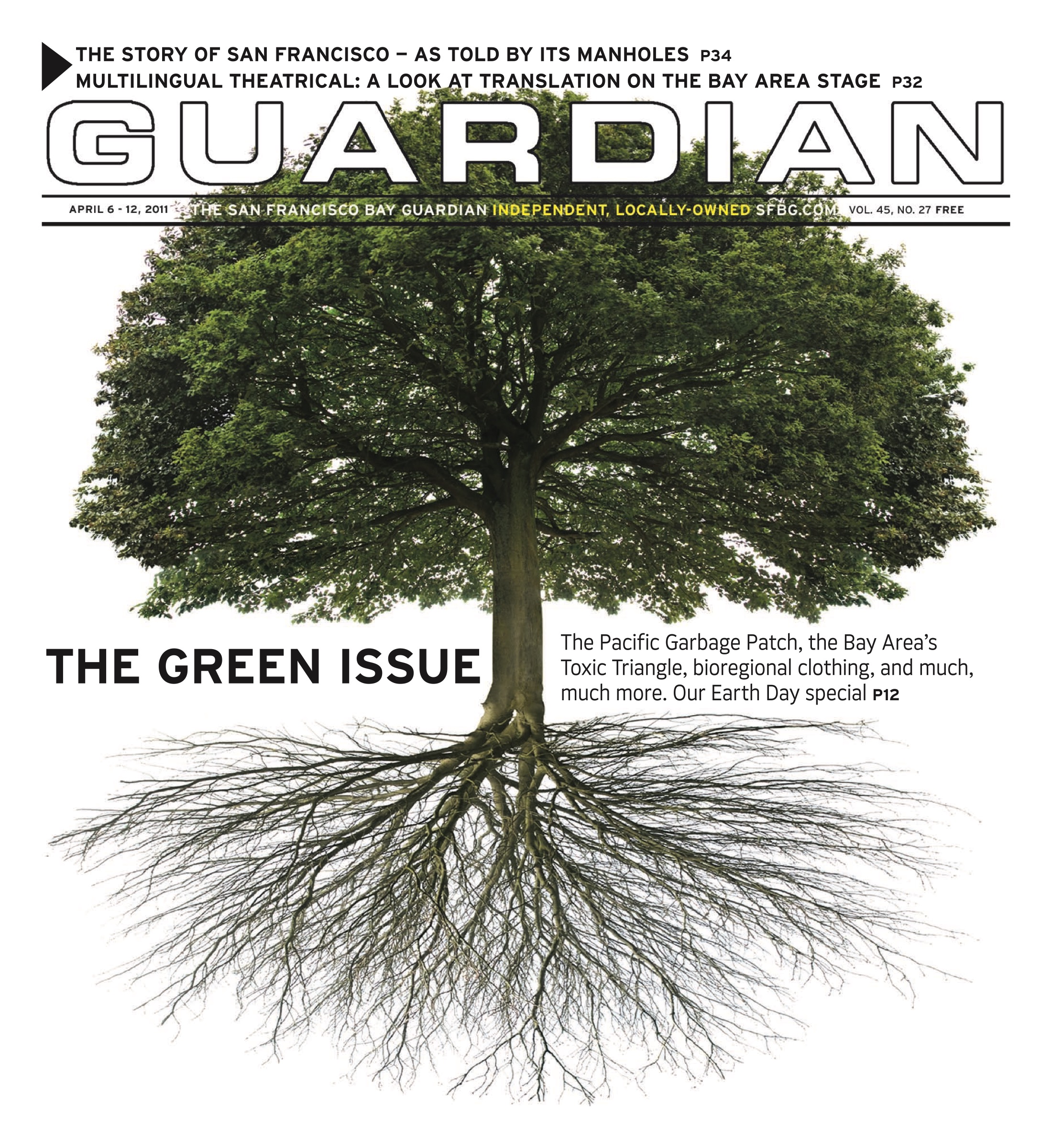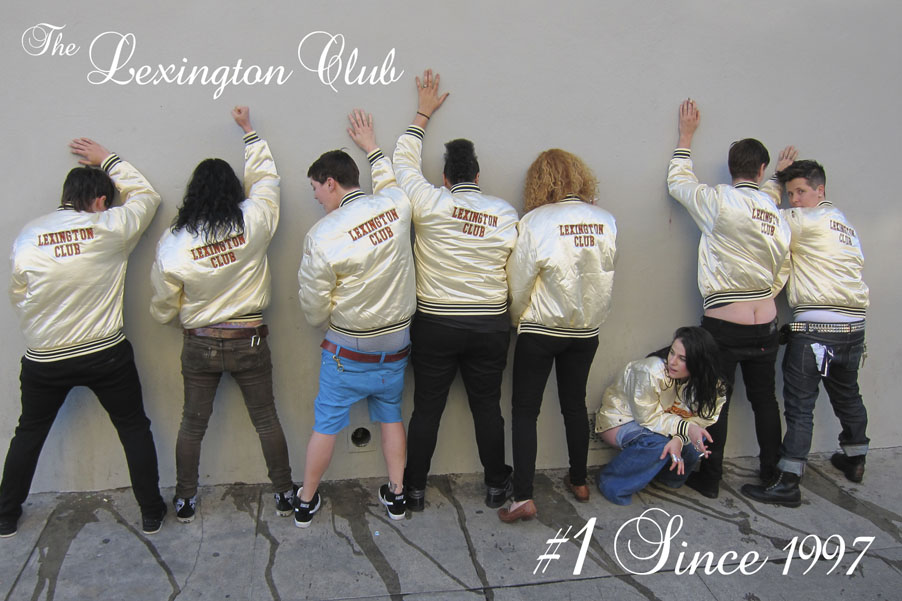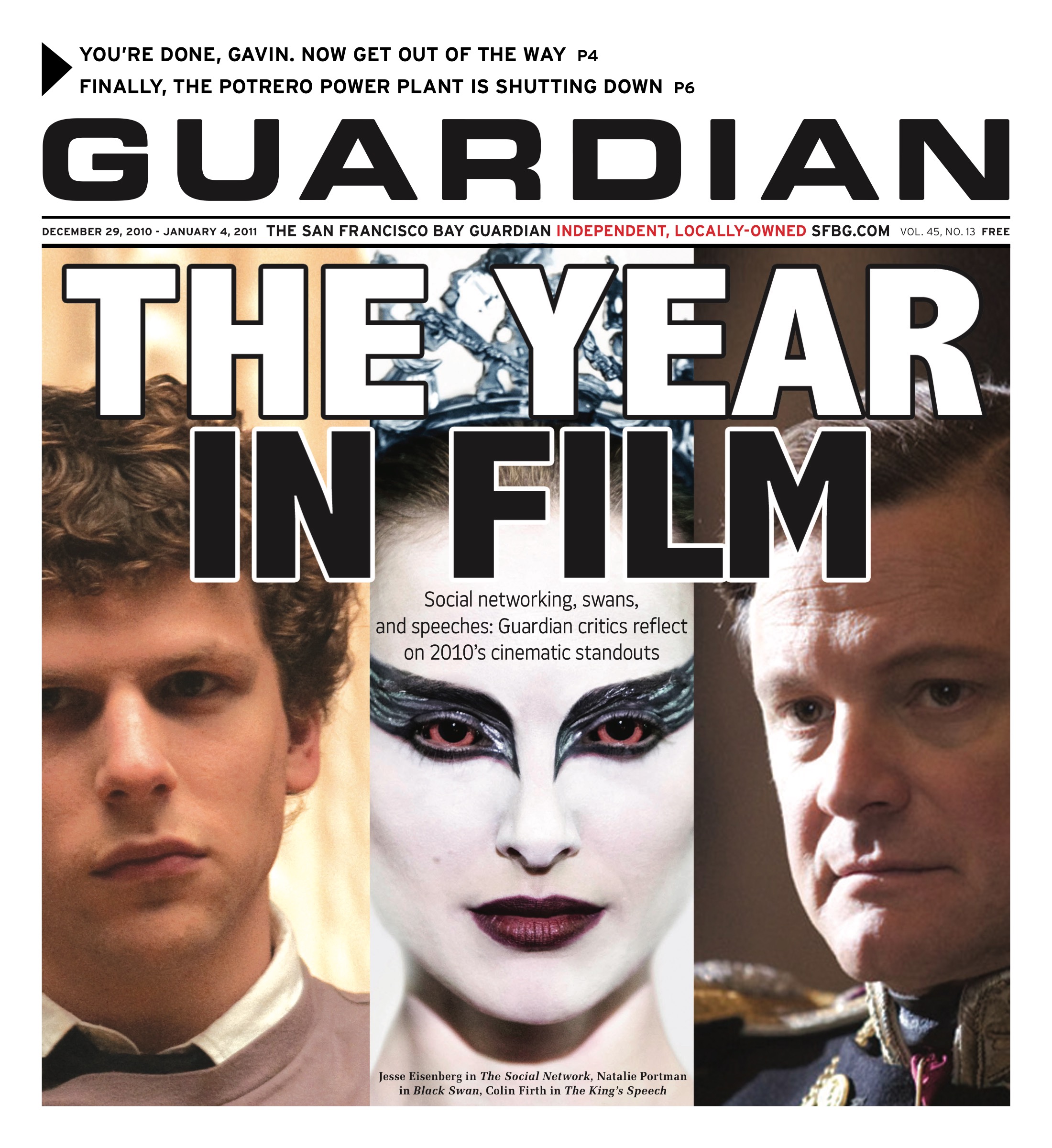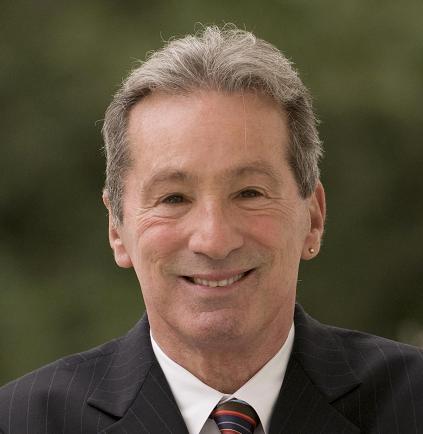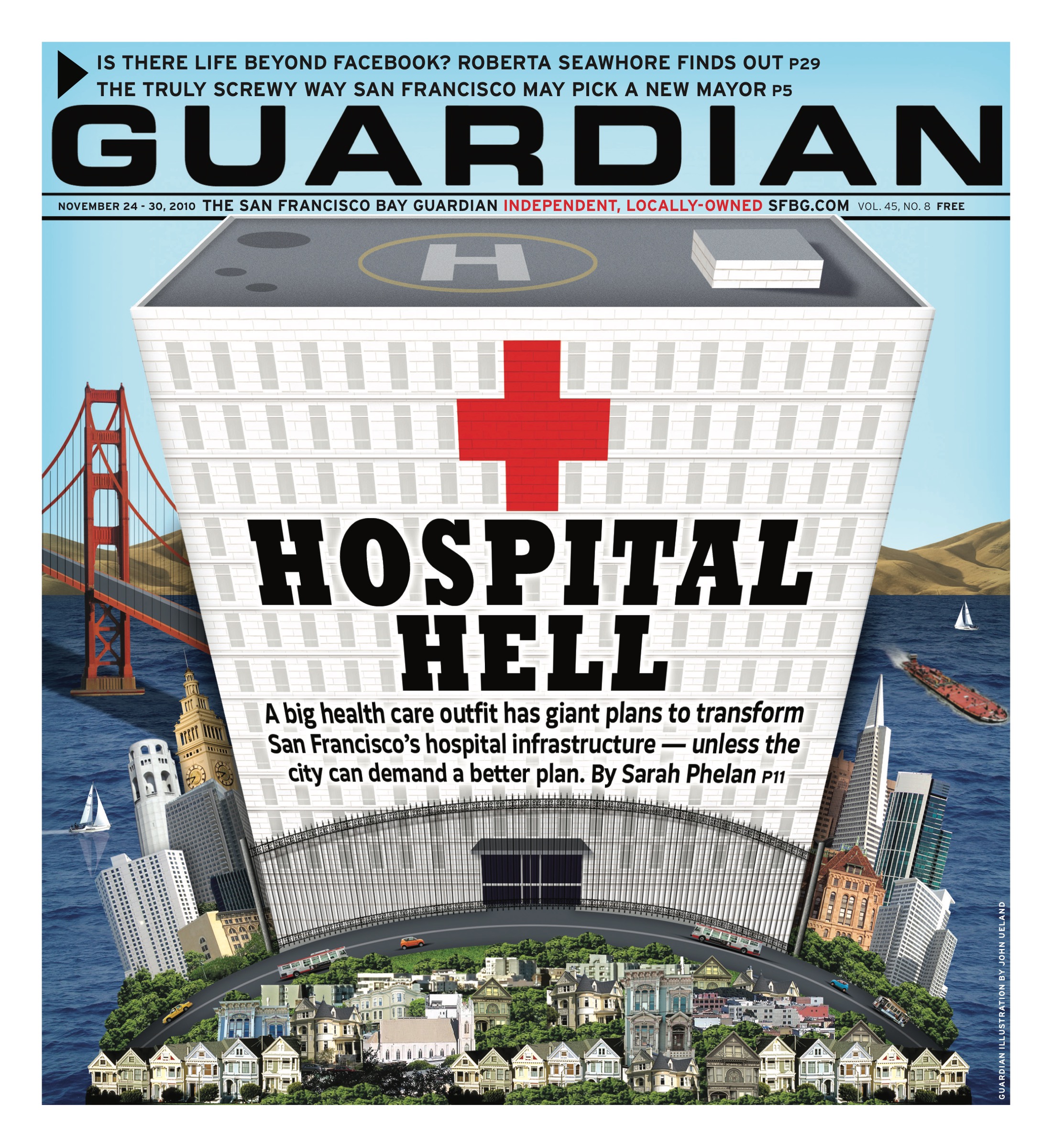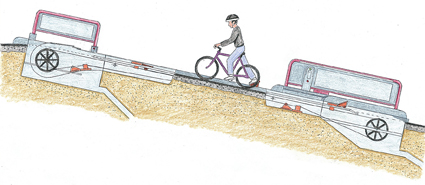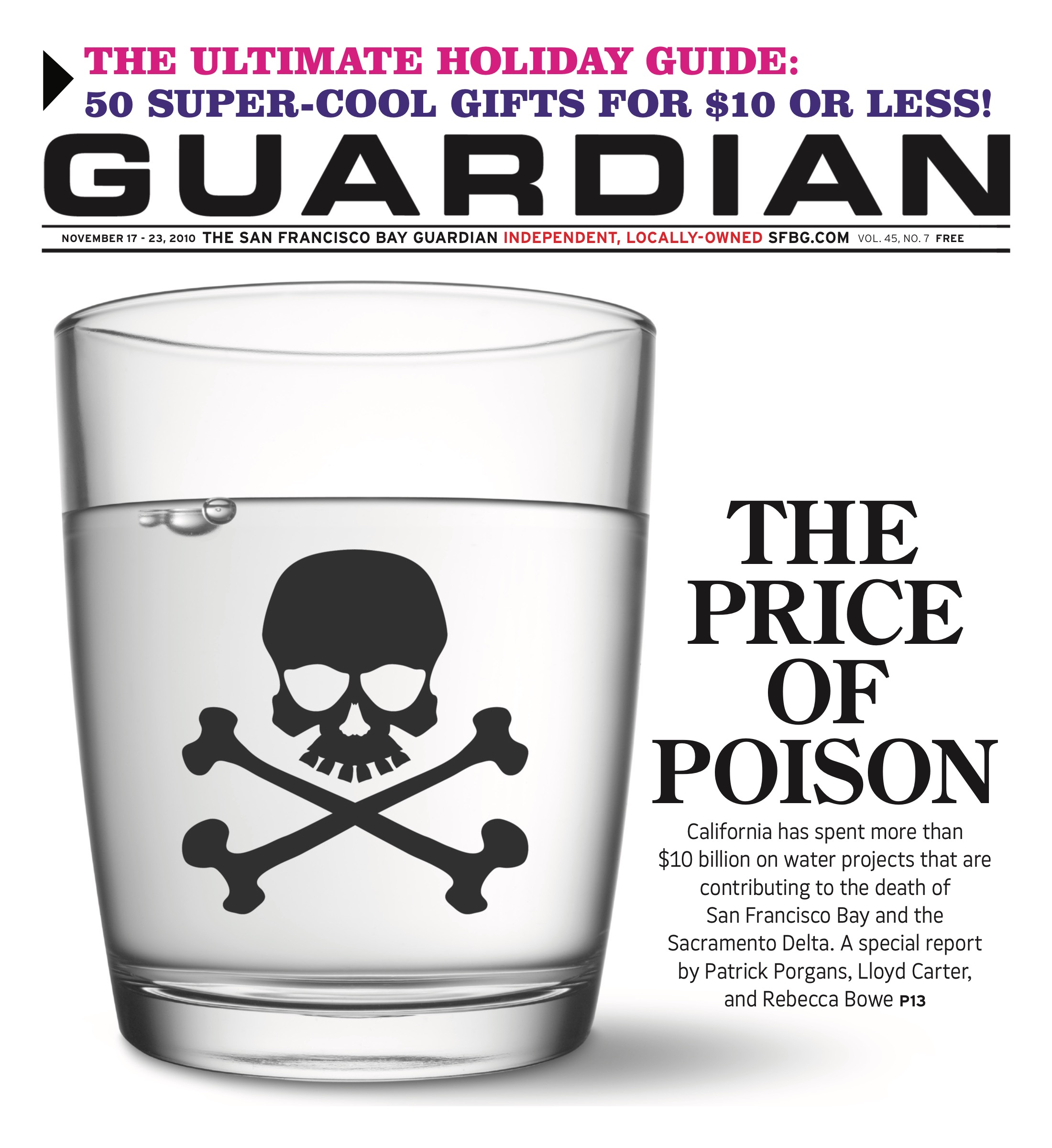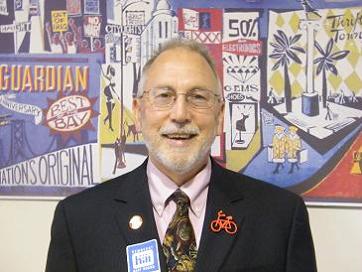Music listings are compiled by Paula Connelly and Cheryl Eddy. Since club life is unpredictable, it’s a good idea to call ahead to confirm bookings and hours. Prices are listed when provided to us. Submit items for the listings at listings@sfbg.com.
WEDNESDAY 22
ROCK/BLUES/HIP-HOP
Blue October, Parlotones Regency Ballroom. 8pm, $32.
"Chinese White Bicycles" Swedish American Hall (upstairs from Café Du Nord). 8pm, $25.
Rick Estrin and the Nightcats Biscuits and Blues. 8 and 10pm, $18.
Golden Gate, Genne and Jesse, Talmaya Hotel Utah. 8pm, $6.
Local Natives, Love Language Fillmore. 8pm, $20.
Murkins, No Captains, Dead Westerns Bottom of the Hill. 9pm, $8.
Ninth Moon Black, Rye Wolves, Burial Tide, DJ Rob Metal Kimo’s. 9pm, $7.
Julie Plug, Skyflakes, Sugarspun Milk Bar. 9pm, $8.
Silent Comedy, Bears! Bears! Bears!, Shauna Regan Knockout. 9pm, $6.
Tank Attack, Zig Zags, Arms N Legs Hemlock Tavern. 9pm, $5.
FOLK/WORLD/COUNTRY
*Rupa and the April Fishes, MWE, Brass Menazeri Rickshaw Stop. 8:30pm, $12-20.
DANCE CLUBS
Booty Call Q-Bar, 456 Castro, SF; www.bootycallwednesdays.com. 9pm. Juanita Moore hosts this dance party, featuring DJ Robot Hustle.
Club Shutter Elbo Room. 10pm, $5. Goth with DJs Nako, Omar, and Justin.
Hands Down! Bar on Church. 9pm, free. With DJs Claksaarb, Mykill, and guests spinning indie, electro, house, and bangers.
Jam Fresh Wednesdays Vessel, 85 Campton, SF; (415) 433-8585. 9:30pm, free. With DJs Slick D, Chris Clouse, Rich Era, Don Lynch, and more spinning top40, mashups, hip hop, and remixes.
Mary-Go-Round Lookout, 3600 16th St, SF; (415) 431-0306. 10pm, $5. A weekly drag show with hosts Cookie Dough, Pollo Del Mar, and Suppositori Spelling.
RedWine Social Dalva. 9pm-2am, free. DJ TophOne and guests spin outernational funk and get drunk.
Respect Wednesdays End Up. 10pm, $5. Rotating DJs Daddy Rolo, Young Fyah, Irie Dole, I-Vier, Sake One, Serg, and more spinning reggae, dancehall, roots, lovers rock, and mash ups.
Synchronize Il Pirata, 2007 16th St, SF; (415) 626-2626. 10pm, free. Psychedelic dance music with DJs Helios, Gatto Matto, Psy Lotus, Intergalactoid, and guests.
THURSDAY 23
ROCK/BLUES/HIP-HOP
Atriarch, Alaric, Worm Ourboboros Knockout. 9:30pm, $6.
Badmammal, Good Luck at the Gunfight, Bonsoir George El Rio. 8pm, $3-5.
*Big Boi Regency Ballroom. 8pm, $35.
Jason Falkner Amoeba, 1855 Haight, SF; www.amoeba.com. 6pm, free.
Jason Falkner, 88, Ferocious Few Slim’s. 8pm, $13.
Alan Iglesias Biscuits and Blues. 8 and 10pm, $16. Stevie Ray Vaughn tribute.
Kelly Mcfarling, Sioux City Kid and the Revolutionary Ramblers, Arann Harris and the
Kina Grannis, Ry Cuming, Imaginary Friend Great American Music Hall. 8pm, $17.
Greenstring Farm Band Café Du Nord. 8pm, $12.
*Midnight Bombers, Get Dead, Psychology of Genocide, New Hope for the Dead Thee Parkside. 9pm, $6.
Mighty Slim Pickins, Clair, Sit Kitty Sit Bottom of the Hill. 9pm, $8.
Tamika Nicole Coda. 9pm, $10.
Sasha and the Shamrocks, Spidermeow, Rabbles Hotel Utah. 9pm, $7.
UB40 Fillmore. 8pm, $49.50.
Water Boarders, Bestial Mouths, Group Rhoda Hemlock Tavern. 9pm, $6.
JAZZ/NEW MUSIC
"Full Moon Concert Series: Harvest Moon" Luggage Store Gallery, 1007 Market, SF; www.luggagestoregallery.org. 8pm, $6-10. With Dan Plonsey, Steve Horowitz, and more.
Sam Grobe-Heinze and Tomoko Funaki Trio Savanna Jazz. 7:30pm, $5.
McCoy Tyner All-Stars Yoshi’s San Francisco. 8 and 10pm, $25-35.
Swing With Stan Rite Spot, 2099 Folsom, SF; www.ritespotcafe.net. 9pm, free.
FOLK/WORLD/COUNTRY
Kardash Enrico, 504 Broadway, SF; (415) 982-6223. 7:30pm.
DANCE CLUBS
Afrolicious Elbo Room. 9:30pm, $10. DJs Pleasuremaker and Señor Oz spin Afrobeat, Tropicália, electro, samba, and funk.
Caribbean Connection Little Baobab, 3388 19th St, SF; (415) 643-3558. 10pm, $3. DJ Stevie B and guests spin reggae, soca, zouk, reggaetón, and more.
Dirty Dishes The LookOut, 3600 16th St., SF; (415) 431-0306. 9pm, $3. With food carts and DJs B-Haul, Gordon Gartrell, and guests spinning indie electro, dirty house, and future bass.
Drop the Pressure Underground SF. 6-10pm, free. Electro, house, and datafunk highlight this weekly happy hour.
Full Moon Contest The Edge, 4149 18th St., SF; (415) 863-4027. 8pm, $8. A PBR benefit beer bust.
Gigantic Beauty Bar. 9pm, free. With DJs Eli Glad, Greg J, and White Mike spinning indie, rock, disco, and soul.
Good Foot Som., 2925 16th St, SF; (415) 558-8521. 10pm, free. With DJs spinning R&B, Hip hop, classics, and soul.
Gymnasium Matador, 10 Sixth St, SF; (415) 863-4629. 9pm, free. With DJ Violent Vickie and guests spinning electro, hip hop, and disco.
Jivin’ Dirty Disco Butter, 354 11th St., SF; (415) 863-5964. 8pm, free. With DJs spinning disco, funk, and classics.
Koko Puffs Koko Cocktails, 1060 Geary, SF; (415) 885-4788. 10pm, free. Dubby roots reggae and Jamaican funk from rotating DJs.
Meat DNA Lounge. 9:30pm, $2-5. Industrial with BaconMonkey, Netik, Mitch, and Ritter Gluck.
Mestiza Bollywood Café, 3376 19th St, SF; (415) 970-0362. 10pm, free. Showcasing progressive Latin and global beats with DJ Juan Data.
Peaches Skylark, 10pm, free. With an all female DJ line up featuring Deeandroid, Lady Fingaz, That Girl, and Umami spinning hip hop.
Popscene 330 Rich. 10pm, $10. Rotating DJs spinning indie, Britpop, electro, new wave, and post-punk.
Solid Thursdays Club Six. 9pm, free. With DJs Daddy Rolo and Tesfa spinning roots, reggae, dancehall, soca, and mashups.
FRIDAY 24
ROCK/BLUES/HIP-HOP
Agent Orange, Daikdaiju, Deadbeats Red Devil Lounge. 8pm, $10.
Bacon, Howdy! Connecticut Yankee, 100 Connecticut, SF; www.theyankee.com. 10pm, $5.
Beautiful Girls, Giant Panda Guerrilla Dub Squad, Kinetix Independent. 9pm, $15.
Big Tree, Brass Bed, Idle Cedars, Grand Lake Hotel Utah. 9pm, $8.
Black Milk, Elzhi, DJ House Shoes, Gary Copp Mighty. 10pm.
Damage Inc, Paradise City, Powerage, Strangers in the Night Slim’s. 9pm, $13.
Shane Dwight Biscuits and Blues. 8 and 10pm, $20.
JJ Grey and Mofro Fillmore. 8:30pm, $25.
Katatonia, Swallow the Sun, Orphaned Land Thee Parkside. 9pm, $18-45.
Tommy Keene, Bye Bye Blackbirds, Paul and John Hemlock Tavern. 9:30pm, $10.
Lee Vilenski Trio Rite Spot, 2099 Folsom, SF; www.ritespotcafe.net. 9pm, free.
New Moon, Rajiv Parikh, Tracorum Great American Music Hall. 9pm, $20.
"The Other Side of the Sidewalk: Concert Tribute to the Songs of Shel Silverstein" Make-Out Room. 7pm, $7. With Misisipi Mike Wolf and friends.
*Rykarda Parasol, Mister Loveless, Spyrals Bottom of the Hill. 10pm, $12.
Pro Leisure, Lowfat Handshake, Hoovers Café Du Nord. 8pm, $10.
Rayband Orchestra Coda. 10pm, $10.
Sick of Sarah, City Light, Here Come the Saviours Rickshaw Stop. 8:30pm, $12.
JAZZ/NEW MUSIC
Chris Braun and Group Savanna Jazz. 7:30pm, $5.
Kinhoua and Eneidi-Golia Quartet Community Music Center, 544 Capp, SF; www.sfcmc.org. 8pm, $12.
McCoy Tyner All-Stars Yoshi’s San Francisco. 8 and 10pm, $30-40.
Olodum Palace of Fine Arts Theatre, 3301 Lyon, SF; www.sfjazz.org. 8pm, $25-65.
FOLK/WORLD/COUNTRY
Meredith Axelrod and Craig Ventresco Amnesia. 6-9pm.
Baxtalo Drom Amnesia. 9pm, $10.
Sharon Hazel Township Dolores Park Café. 7pm, $5.
DANCE CLUBS
*Albino!, J. Boogie Elbo Room. 10pm, $10.
Club Dragon Club Eight, 1151 Folsom, SF; www.eightsf.com. 9pm, $8. A gay Asian paradise. Featuring two dance floors playing dance and hip hop, smoking patio, and 2 for 1 drinks before 10pm.
*Duniya Dancehall Blue Macaw, 2565 Mission, SF; (415) 920-0577. 10pm, $10. With live performances by Duniya Drum and Dance Co. and DJs dub Snakr and Juan Data spinning bhangra, bollywood, dancehall, African, and more.
Exhale, Fridays Project One Gallery, 251 Rhode Island, SF; (415) 465-2129. 5pm, $5. Happy hour with art, fine food, and music with Vin Sol, King Most, DJ Centipede, and Shane King.
Fat Stack Fridays Koko Cocktails, 1060 Geary, SF; (415) 885-4788. 10pm, free. With rotating DJs B-Cause, Vinnie Esparza, Mr. Robinson, Toph One, and Slopoke.
Flying Lotus, Caspa Mezzanine. 9pm, $20.
Fubar Fridays Butter, 354 11th St., SF; (415) 863-5964. 6pm, $5. With DJs spinning retro mashup remixes.
Good Life Fridays Apartment 24, 440 Broadway, SF; (415) 989-3434. 10pm, $10. With DJ Brian spinning hip hop, mashups, and top 40.
Hot Chocolate Milk. 9pm, $5. With DJs Big Fat Frog, Chardmo, DuseRock, and more spinning old and new school funk.
House of Voodoo Medici Lounge, 299 9th St., SF; (415) 863-6334. 9pm. With DJs voodoo and Purgatory spinning goth, industrial, deathrock, eighties, and more.
Psychedelic Radio Club Six. 9pm, $7. With DJs Kial, Tom No Thing, Megalodon, and Zapruderpedro spinning dubstep, reggae, and electro.
Rockabilly Fridays Jay N Bee Club, 2736 20th St, SF; (415) 824-4190. 9pm, free. With DJs Rockin’ Raul, Oakie Oran, Sergio Iglesias, and Tanoa "Samoa Boy" spinning 50s and 60s Doo Wop, Rockabilly, Bop, Jive, and more.
Some Thing The Stud. 10pm, $7. VivvyAnne Forevermore, Glamamore, and DJ Down-E give you fierce drag shows and afterhours dancing.
Teenage Dance Craze Party Knockout. 10pm, $3. Twist, surf, and garage with DJs Sergio Iglesias, Russell Quann, and dX the Funky Gran Paw.
Trannyshack Lady Gaga Tribute DNA Lounge. 10pm, $15. Don’t forget your disco stick!
SATURDAY 25
ROCK/BLUES/HIP-HOP
Barney Cauldron, Grains, Midnite Snackers Li Po Lounge, 916 Grant, SF; (415) 982-0072. 9pm, $5.
Christmas, MOR, Pandiscordion Necrogenesis, Statutory Apes Amnesia. 9pm, $5.
Covered in Butter, Treehouse, Expostwave, Tremor Low El Rioncon. 9pm, $5.
Dirty Projectors Fillmore. 9pm, $25.
Disastroid, Tender, Lost Puppy Thee Parkside. 3pm, free.
Freezepop, Ming and Ping, Aerodrone Elbo Room. 10pm, $13.
Kyro, Kate Burkart, Melissa Phillips Hotel Utah. 9pm, $8.
Monophonics, Grillade Independent. 9pm, $14.
Mucca Pazza, Rube Waddell Bottom of the Hill. 10pm, $12.
Paul Collins’ Beat, Pleasure Kills, Sharp Objects Hemlock Tavern. 9:30pm, $10.
*"Polk Street Blues Festival" Polk between Pacific and Union, SF; www.sresproductions.com. 10am-6pm, free.
Roy G. Biv and the Mneumonic Devices, Katie Garibaldi, Karney, Amanda Abizaid Union Room at Biscuits and Blues. 8pm, $10.
Earl Thomas and the Blues Ambassadors Biscuits and Blues. 8 and 10pm, $22.
"West Coast Zoner Jam IV" Jerry Garcia Amphitheater, McLaren Park, 45 Shelley, SF; www.zonerjam.com. Noonn-6pm, free. With Lost Ticket, Left Coasting, Dedicated Maniacs, and more.
JAZZ/NEW MUSIC
Chris Potter Underground Yerba Buena Center for the Arts, 701 Mission, SF; www.sfjazz.org. 8pm, $30-50.
Giovenco Project Coda. 7 and 10pm, $7-10.
"Infrasound 25" Southern Exposure, 3030 20th St, SF; www.soex.org. 7:30pm, free. With Scott Arford, Randy Yau, and Michael Gendreau.
McCoy Tyner All-Stars Yoshi’s San Francisco. 8 and 10pm, $40.
Karen Segal and Group Savanna Jazz. 7:30pm, $8.
FOLK/WORLD/COUNTRY
Barbary Ghosts, Salty Walt and the Rattlin’ Ratlines On the ship Balcutha, Hyde Street Pier, Hyde at Jefferson, SF; (415) 447-5000. 8pm, $14.
*Toshio Hirano Rite Spot, 2099 Folsom, SF; www.ritespotcafe.net. 9pm, free.
Orquesta America The Ramp, 855 Terry Francois, SF; (415) 621-2378. 5:15pm, $5.
Teslim Seventh Avenue Performances, 1329 7th Ave., SF; (415) 664-2543. 7:30pm, $20. Turkish and Sephardic music.
Craig Ventresco and Meredith Axelrod Atlas Café. 4pm, free.
DANCE CLUBS
AIDS Emergency Fund Benefit DNA Lounge. 12:30-6pm, $10. Dance to house music, mingle with Folsom friends, and donate to a good cause at this annual event.
Bar on Church 9pm. Rotating DJs Foxxee, Joseph Lee, Zhaldee, Mark Andrus, and Nuxx.
Barracuda 111 Minna. 9pm, $10. Eclectic 80s music with DJs Damon and Phillie Ocean plus 80s cult video projections, a laser light show, prom balloons, and 80s inspired fashion.
Bay Area All Star Series Club Six. 9pm, $5. With live performances by Hav Knots, Micah Tron, Kaveman, The Freshmen, and Z-Man.
Blowoff Slim’s. 10pm, $15. With DJs Bob Mould and Rich Morel.
Bootie DNA Lounge. 9pm, $6-12. Bootie Berlin’s resident DJ, Mashup-Germany, guests with residents Adrian and Mysterious D.
Cockblock Rickshaw Stop. 10pm, $5-7. Queer dance party with DJ Nuxx and friends.
Go Bang! Deco Lounge, 510 Larkin, SF; (415) 346 – 2025. 9pm, $5. Recreating the diversity and freedom of the 70’s/ 80’s disco nightlife with DJs Adrian Santos, Steve Fabus, Tres Lingerie, Sergio, and more.
HYP Club Eight, 1151 Folsom, SF; www.eightsf.com. 10pm, free. Gay and lesbian hip hop party, featuring DJs spinning the newest in the top 40s hip hop and hyphy.
Marcus Schossow, Second Sun 1015 Folsom. 10pm, $15.
Reggae Gold Club Six. 9pm, $15. With DJs Daddy Rolo, Polo Mo’qz, and Veyn spinning dancehall, reggae, and soca.
Roc Raida Tribute Som. 10pm, $5. With MCs Rakaa and DJs Rob Swift, Platurn, Blaqwest, Mr. E, and Umami spinning hip hop.
Rock City Butter, 354 11th St., SF; (415) 863-5964. 6pm, $5 after 10pm. With DJs spinning party rock.
*Ships in the Night and Sissy Strut Underground SF. 10pm, $5. Two queer dance parties come together to raise money for Teachers for Social Justice with DJs Black, Durt, and guests spinning soul, motown, R&B, doo wop, hip hop, and booty jams.
Spirit Fingers Sessions 330 Ritch. 9pm, free. With DJ Morse Code and live guest performances.
Temptation Cat Club. 9:30pm, $7. A femme fatales night with DJs Melting Girl, Daniel Skellington, Skip, Dangerous Dan, and more spinning new wave, goth, electro, and more in preparation for the Folsom Street Fair.
SUNDAY 26
ROCK/BLUES/HIP-HOP
Bone Cootes, Two Sheds Rite Spot, 2099 Folsom, SF; www.ritespotcafe.net. 9pm, free.
Corruptors, Mensclub, Hot Fog, Sassy!!! Bottom of the Hill. 3pm, $8.
Trevor Garrod Café Du Nord. 8pm, $12.
*Git Some, Pins of Light, Hazzard’s Cure Knockout. 7:30pm, $6.
Nevermore, Warbringer, Mutiny Within, Hatesphere Slim’s. 8pm, $23.
*"Polk Street Blues Festival" Polk between Pacific and Union, SF; www.sresproductions.com. 10am-6pm, free.
Riot Before, Young Livers, Big Kids, Tigon Thee Parkside. 8pm, $7.
Social Studies, Jared Mees and the Grown Children, Monarques Hemlock Tavern. 8pm, $8.
Y La Bamba, Typhoon, Kacey Johansing Amnesia. 9pm, $7.
FOLK/WORLD/COUNTRY
John Calloway and Diaspora Coda. 7pm, $10.
Famous Thee Parkside. 4pm, free.
Forro Brazuca The Ramp, 855 Terry Francois, SF; (415) 621-2378. 5:15pm, $5.
Andre Thierry and Zydeco Magic Knockout. 2-6pm, $10.
DANCE CLUBS
DiscoFunk Mashups Cat Club. 10pm, free. House and 70’s music.
Dub Mission Elbo Room. 9pm, $6. DJ Sep, Vinnie Esparza, and Lud Dub spin dub, roots, and classic dancehall.
Gloss Sundays Trigger, 2344 Market, SF; (415) 551-CLUB. 7pm. With DJ Hawthorne spinning house, funk, soul, retro, and disco.
Honey Soundsystem Paradise Lounge. 8pm-2am. "Dance floor for dancers – sound system for lovers." Got that?
Jock! Lookout, 3600 16th St, SF; (415) 431-0306. 3pm, $2. This high-energy party raises money for LGBT sports teams.
Kick It Bar on Church. 9pm. Hip-hop with DJ Zax.
Lowbrow Sunday Delirium. 1pm, free. DJ Roost Uno and guests spinning club hip hop, indie, and top 40s.
Religion Bar on Church. 3pm. With DJ Nikita.
Stag AsiaSF. 6pm, $5. Gay bachelor parties are the target demo of this weekly erotic tea dance.
Superbad Sundays Koko Cocktails, 1060 Geary, SF; (415) 885-4788. 10pm, free. With DJs Slopoke, Booker D, and guests spinning blues, oldies, southern soul, and funky 45s.
Swing Out Sundays Rock-It Room. 7pm, free (dance lessons $15). DJ BeBop Burnie spins 20s through 50s swing, jive, and more.
MONDAY 27
ROCK/BLUES/HIP-HOP
Lotus Moons, These Hills of Gold, Skystone Knockout. 9pm, $7.
Orchestra Antlers, Threadspinner, Westwood and Willow Elbo Room. 9pm, $6.
Perfume Genius, Winfred E. Eye, Mist and Mast Bottom of the Hill. 9pm, $12.
FOLK/WORLD/COUNTRY
Natalia Lafourcade Slim’s. 8pm, $21.
DANCE CLUBS
Black Gold Koko Cocktails, 1060 Geary, SF; (415) 885-4788. 10pm-2am, free. Senator Soul spins Detroit soul, Motown, New Orleans R&B, and more — all on 45!
Death Guild DNA Lounge. 9:30pm, $3-5. Gothic, industrial, and synthpop with Decay, Joe Radio, and Melting Girl.
Krazy Mondays Beauty Bar. 10pm, free. With DJs Ant-1, $ir-Tipp, Ruby Red I, Lo, and Gelo spinning hip hop.
M.O.M. Madrone Art Bar. 6pm, free. With DJ Gordo Cabeza and guests playing all Motown every Monday.
Manic Mondays Bar on Church. 9pm. Drink 80-cent cosmos with Djs Mark Andrus and Dangerous Dan.
Musik for Your Teeth Revolution Café, 3248 22nd St., SF; (415) 642-0474. 5pm, free. Soul cookin’ happy hour tunes with DJ Antonino Musco.
Network Mondays Azul Lounge, One Tillman Pl, SF; www.inhousetalent.com. 9pm, $5. Hip-hop, R&B, and spoken word open mic, plus featured performers.
Skylarking Skylark. 10pm, free. With resident DJs I & I Vibration, Beatnok, and Mr. Lucky and weekly guest DJs.
TUESDAY 28
ROCK/BLUES/HIP-HOP
Fat Tuesday Band Biscuits and Blues. 8 and 10pm, $15.
*Fennesz, Odd Nosdam Swedish American Hall (upstairs from Café Du Nord). 8pm, $20.
Sarah Harmer, Bahamas Independent. 8pm, $20.
Hold Me Luke Allen, AJ Rivlin El Rio. 9pm, free.
Like, Hounds Below, Myonics Rickshaw Stop. 8pm, $12.
Ryat, Dominique Leone, Religious Girls Elbo Room. 9pm, $5.
Semi Precious Weapons, DJ Lady Starlight Slim’s. 8:30pm, $18.
DANCE CLUBS
Eclectic Company Skylark, 9pm, free. DJs Tones and Jaybee spin old school hip hop, bass, dub, glitch, and electro.
Rock Out Karaoke! Amnesia. 7:30pm. With Glenny Kravitz.
Rusko, Michipet, Neptune Mezzanine. 9pm, $18.
Share the Love Trigger, 2344 Market, SF; (415) 551-CLUB. 5pm, free. With DJ Pam Hubbuck spinning house.
Stump the Wizard Argus Lounge. 9pm, free. Punk, hardcore, metal, country, and more with DJ What’s His Fuck and DJ the Wizard.
Womanizer Bar on Church. 9pm. With DJ Nuxx.


